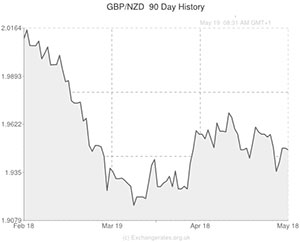
The Pound to New Zealand Dollar (GBP/NZD) tumbled by around a third of a cent during the Asian session as markets reacted to some stronger-than-anticipated data in the Pacific region.
Sterling started to slide just before midnight when Statistics New Zealand reported that producer output prices rose by 0.9% in the first quarter, beating estimates of a 0.7% increase. The report also detailed that producer input prices grew by 1.0% compared to forecasts of 0.4%. The majority of the price increases were influenced by a large jump in the price of electricity and gas. Fuel output costs increased by 14% and fuel input costs surged by 20%.
Chris Pike from Statistics New Zealand said:
“The higher prices for electricity generation contributed to both the higher input and output PPIs in the last quarter. This often happens in March quarters, due to spot-market conditions and low lake levels”.
The ‘Kiwi’ Dollar was also boosted by a decent domestic service sector PMI report. The tertiary industry indicator rose from 58.3 to a 6-year high of 58.9 in April which, combined with recent manufacturing data, suggests that the New Zealand economy is on course for expansion of around 4.0% this year. This should ensure that the Reserve Bank of New Zealand will continue to tighten monetary policy over the next few months.
The RBNZ stated last autumn that it intends to raise the benchmark interest rate to around 4.75% over the next two years. Two 25 basis point rate hikes have occurred already this year and the overnight cash rate currently stands at 3.00% – six times as high as the Bank of England’s meagre 0.50%. This makes the New Zealand Dollar more appealing to investors and GBP/NZD has fallen by around eight cents since the beginning of the year.
Demand for the ‘Kiwi’ took another unexpected turn for the better in response to an impressively high Japanese machine orders print of 19.1%. The rapid growth was interpreted as bullish for the New Zealand Dollar because Japan is one of the Antipodean nation’s largest export markets. The prevailing attitude among traders is that a strong Japanese economy will likely lead to robust export growth from New Zealand.
There is little on the economic docket later today, however there is a key UK data release scheduled to be announced tomorrow morning at half-past nine. The highly anticipated consumer price index report is anticipated to show that price pressures accelerated from March’s 4-year low of 1.6% to 1.7% during April. If the inflation print comes in at 1.7% or above then it could potentially give Sterling a little bit of a boost because it could be seen to raise the prospect of an interest rate hike from the BoE before the second quarter of next year.

Comments are closed.